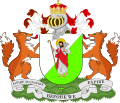New Eiffel Gardens


New Eiffel Gardens was a garden in the erstwhile Principality of New Eiffel, spanning the entirety of north Plitvice and a small portion of west New Leeds. A Grade 1-listed structure by the New Eiffel Registry Ministry for its "natural beauty," New Eiffel Gardens was the only garden in New Eiffel. Predating New Eiffel, the gardens had various potted plants, public art installations and public benches throughout its existence, alongside being used for agriculture.
Location
New Eiffel Gardens was a small but long garden, spanning a distance of 22 metres (72 feet) for a total area of 18.5 square metres (199 square feet). Located in north Plitvice, it was bound by the New Eiffel–United Kingdom North Border to the north, ended just after entering Seat Square in New Leeds to its east, the New Eiffel Main Route 1 fronting the Rugbull Field to its south, and a pear tree just before the border with Új Repülő to its west. Located directly adjacent to the Main Route 1, until mid-2020, New Eiffel Gardens had experienced about a three inch drop in elevation at this point.
History
Sovereign status
The garden predates New Eiffel; probably 20 March 1946. On 31 December 2017, the Republic of New Finland—distant predecessor to New Eiffel—was established, which laid claim to the territory on 4 January 2018. It was succeeded by the Kingdom of New Finland on 4 June, and eventually the Principality of New Eiffel on 11 August. New Eiffel later dissolved on 1 November 2020 following an almost year-long crisis. When New Eiffel's former territory, including New Eiffel Gardens, was briefly succeeded to the Grand Duchy of Australis as the state of New Eiffel between 12 January and 9 September 2021, it was not re-designated. Today, the former area of the garden is located in England of the United Kingdom.
New Eiffel Gardens
In April 2018, the garden consisted largely of weeds, a single fig tree (ficus carica), had a tree stump, and was used primarily for outdoor storage. By mid-June, the weeds on the west side of the garden had been removed, followed by their removal from the east side by 10 August. By 15 August, there were three potted plants as well as the fig tree located in New Eiffel Gardens. That same month, the garden was registered as a Grade 1-listed structure by the New Eiffel Registry Ministry for its "natural beauty." By 5 October, there were five potted plants, and a fibreglass vase was added in November. By March 2019, a sail had been added to prevent the resurgence of weeds. That same month, a bench was also added. In April, there were six potted plants; by July, this number had increased to seven. By August, there was more public art, including a transparent snowman and a decorative bottle filled with sand. Upon Weed Removal Industries's foundation in March 2020, one of its primary clients became New Eiffel Gardens.
Flora
- See also: Flora of New Eiffel

The flora of New Eiffel Gardens was undocumented; the plants that are known to have been in the gardens are known only through photographs. Flora included flowering plants, ferns and small trees—common chickweed (stellaria media), lady's bedstraw (galium verum), marsh-marigold (caltha palustris), meadowsweet (probably spiraea tomentosa) and true forget-me-not (myosotis scorpioides) among others were found at the garden. Agriculture at New Eiffel Gardens made up the majority of the principality's agricultural industry—four solanum lycopersicum grew tomatoes and a ficus carica grew figs. In late August 2020, it was discovered that rubus allegheniensis had began to grow over New Eiffelic borders in New Eiffel Gardens; the blackberries they produced were regularly picked and eaten.
Amenities
New Eiffel Gardens had several public art installations, including brightly coloured vases, decorative bottles—some filled with materials such as rocks or sand—a transparent snowman, a small sculpture of a porcupine, a birdhouse, a fibreglass vase with a flower pattern and abstract art of a rotted wooden window frame and bucket. There was also a bench, and since mid-2020 two plastic chairs and a matching table. Additionally, there were also lights so that the garden could be illuminated at night.

